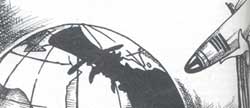USA confronts Third World on nuclear front
 A US high-level military planning group has issued a report strongly recommending the development of nuclear weapons for specific use against Third World enemies. Some of the proposed weapons include an electromagnetic pulse bomb that can knock out enemy communications and other electronic gear at low risk to human beings and a small-yield bomb that would penetrate the earth to a depth of 15 m, triggering off a localised earthquake capable of destroying command bunkers of the kind that housed Iraqi President Saddam Hussein in the last Gulf war.
A US high-level military planning group has issued a report strongly recommending the development of nuclear weapons for specific use against Third World enemies. Some of the proposed weapons include an electromagnetic pulse bomb that can knock out enemy communications and other electronic gear at low risk to human beings and a small-yield bomb that would penetrate the earth to a depth of 15 m, triggering off a localised earthquake capable of destroying command bunkers of the kind that housed Iraqi President Saddam Hussein in the last Gulf war.
The report, named after Thomas Reed, a former US air force secretary and member of the National Security Council, who also headed the study group commissioned by the Joint Strategic Target Planning Staff which evolved USA's central nuclear war plan, is blunt in its proposals. These include the establishing of a so-called nuclear expeditionary force "primarily for use against China or Third World targets".
Another recommendation of the panel is that the US should unhesitatingly counter "nuclear weapons states (and) despotic states (that) seek to deter the United States and other powers from interfering with their regional aggressions". The group's rationale for this recommendation, and another that urges the US to be bullish in nuclear weapons development, is that "the growing wealth of petro-nations and newly hegemonistic powers is available to bullies and crazies, if they gain control, to wreak havoc on world tranquillity".
The report stressed that the new nuclear weapons should have highly flexible designs, with interchangeable components that would allow their launch from land, sea or air and that can be used not only against the enemy's nuclear forces but also against its conventional forces.
Two other nuclear weapons under study are a "micro-nuke", with a destructive force equivalent to 9,000 kgs of high explosives, which could intercept ballistic missiles, and a "mini-nuke" with a ten-fold increase in yield that could be used for "demonstration shots" to convey the determination of the US to resist Third World threats to its interests.
Though the Reed report's recommendations are being perceived as the core of post-Cold War, US nuclear policy, they have not yet been formally endorsed by the Bush administration. The Bulletin of the Atomic Scientists (Vol. 48 No. 3) has critiqued the recommendations by bluntly asserting that the report's real objective was "to save their beloved nuclear weapons complex".
With the US having conducted four A-tests this year, it is becoming increasingly clear that while its leadership is not averse to exerting every kind of pressure on India and other developing countries to sign a nuclear non-proliferation treaty, it keeps its own nuclear arms programme surging full speed ahead.
The language of the Reed report only accentuates the menace in its warnings to nations that do not subscribe to the state of the world as seen from the Pentagon.
